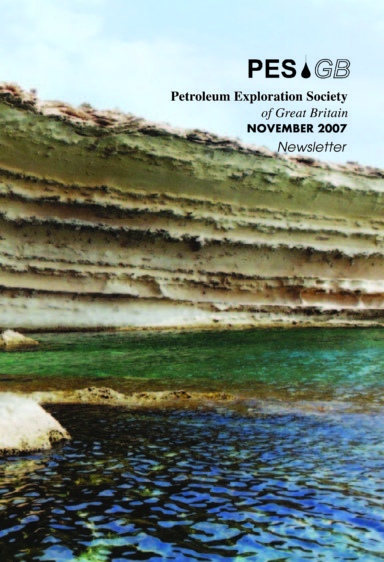PESGB November 2007
President’s Page- Stephen Pickering
In a few days time I will be attending a “fancy dress” dinner hosted by the History of Geology Group to celebrate the bicentenary of the Geological Society of London. Many of our famous
geological forefathers have oil and gas fields named after them … Murchison, Lapworth, Lyell, McCulloch, Wollaston, but which one will I go as? Well for me there is only one choice it must be Hugh Miller.
Hugh Miller was a stonemason and self-taught geologist, whose most famous work was “The Old Red Sandstone, or, new walks in an old field” published in 1841, and containing words of advice relevant to geoscientists today; for example “Such is the state of progression in geological science, that the geologist who stands still but for a very little, must be content to find himself left behind.” Wise words indeed! Like Miller, as an undergraduate I searched for fossil anaspid and cephalaspid fish in the Old Red Sandstone of Scotland, and as a graduate student I studied the Upper Kimmeridgian stratigraphy on the margins of the Moray Firth, close to where Miller was born. Miller’s lovely little cottage in Cromarty is maintained by the National Trust for Scotland, it is well worth a visit. From the cottage you can see drilling rigs at anchor in Nigg Bay.
Further north at Lothbeg the uppermost Jurassic, Allt na Cuile Sandstone, outcrops in the hanging wall of the Helmsdale Fault. Sediments of similar age and provenance, distal turbiditic
sandstones, constitute the reservoir further east in the Miller Field. Having produced some 250 million barrels of oil and 500 BCF gas, the Miller Field, like myself, has reached maturity and is nearing the end of its productive life – or have we?
The operator planned an ambitious carbon sequestration program, using carbon generated from a “carbon-free” electricity power-station to enhance recovery from the field by 40 million barrels oil. The project was shelved earlier this year when it was announced that all carbon storage schemes had to compete for funding and tax relief, the winner to be picked around 2010. The reasoning behind this pronouncement is unclear, but the impact was immediate. Asked to maintain platforms, pumps, and pipelines for three years in a dead oil field, the operator promptly dropped the Miller project.
As Hugh Miller said, we need “new walks for old fields” if we are to defer peak oil and help the planet deal with the challenges of global warming. If the industry in the North Sea is to have a future it is exactly this type of project which must go-ahead – it seems a lost opportunity we can ill-afford! Our industry faces several new challenges, not least, climate change, peak oil and the “big crew change”. The way we all respond is critical if more opportunities are not to be lost. As geoscientists in the decades to come we are just as likely to be planning wells to sequester carbon as we are to produce hydrocarbons; and interpreting time-lapse seismic surveys for monitoring fluid fronts in EOR programmes, as we are to be interpreting seismic in frontier basins. In this business environment “The geologist who stands still ….. must be content to find himself left behind”, and I will not be one of them.


